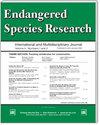在西印度洋筑巢的雌性玳瑁海龟数量呈减少趋势
IF 2.9
2区 环境科学与生态学
Q2 BIODIVERSITY CONSERVATION
引用次数: 0
摘要
摘要:近几十年来,全球范围内都有筑巢海龟体型减小的记录,并将其归因于环境、生态和人口变化的综合影响,以及对生殖产出潜在负面影响的担忧。我们的研究探讨了塞舌尔筑巢玳瑁体型的长期趋势以及可能的人口因素。1974-2022年期间,在两个相邻岛屿(Cousine岛和Cousin岛)筑巢的雌性玳瑁的平均弯曲甲壳长度(CCL)显著下降(0.05 cm yr-1)。在库辛岛,计算了成体增长率,并区分了 2002-2022 年间的新迁入(招募)和迁出筑巢者。生长率与 0 有明显差异(0.18 厘米/年-1)。新迁入者的 CCL 显著下降(0.19 厘米/年-1),而迁回者的 CCL 显著增加(0.12 厘米/年-1)。2002-2022年期间,新迁入者和迁回者的年数量和比例有所波动,但新迁入者的比例从2013年起显著增加,这是在库辛开始完全保护和增加孵化生产约20年之后。窝卵大小与CCL呈正相关,自1992年以来,每年的窝卵数量都在显著增加。我们的结论是,体型的整体下降趋势可能是由于过去十年中新生幼体CCL的下降和新生幼体比例的增加造成的。与此同时,保护措施使新秀得以存活下来,并在多个筑巢季节反复繁殖,随着时间的推移,体型逐渐变大,产下更大的卵,最终提高了整个种群的繁殖产量。本文章由计算机程序翻译,如有差异,请以英文原文为准。
Nesting female hawksbill sea turtles trending smaller in the western Indian Ocean
ABSTRACT: Decreasing body size in nesting sea turtles has been documented globally in recent decades and attributed to a combination of environmental, ecological, and demographic changes, along with concerns about potential negative consequences for reproductive output. Our study examines long-term trends in body size of nesting hawksbill turtles Eretmochelys imbricata in the Seychelles and the likely demographic factors that may be responsible. The average curved carapace length (CCL) declined significantly from 1974-2022 (0.05 cm yr-1) for females nesting at 2 neighbouring islands, Cousine and Cousin. At Cousine Island, adult growth rates were calculated, and neophyte (recruit) and remigrant nesters were distinguished from 2002-2022. Growth was significantly different from 0 (0.18 cm yr-1). Neophyte CCL declined significantly (0.19 cm yr-1), while CCL of returning remigrants increased significantly (0.12 cm yr-1). The annual number and proportion of neophytes and remigrants fluctuated throughout 2002-2022, but the proportion of neophytes significantly increased from 2013 onward, approximately 20 yr after complete protection and increased hatchling production began at Cousine. Clutch size correlated positively with CCL, and annual clutch numbers have been increasing significantly since 1992. We conclude that overall declining trends in body size likely result from declining neophyte CCLs combined with increasing proportions of neophytes over the last decade. Meanwhile, conservation measures have enabled neophytes to survive to breed repeatedly during multiple nesting seasons and, over time, to grow bigger, produce larger egg clutches, and ultimately enhance the reproductive output of the entire population.
求助全文
通过发布文献求助,成功后即可免费获取论文全文。
去求助
来源期刊

Endangered Species Research
BIODIVERSITY CONSERVATION-
CiteScore
5.50
自引率
6.50%
发文量
38
审稿时长
31 weeks
期刊介绍:
ESR is international and interdisciplinary. It covers all endangered forms of life on Earth, the threats faced by species and their habitats and the necessary steps that must be undertaken to ensure their conservation. ESR publishes high quality contributions reporting research on all species (and habitats) of conservation concern, whether they be classified as Near Threatened or Threatened (Endangered or Vulnerable) by the International Union for the Conservation of Nature and Natural Resources (IUCN) or highlighted as part of national or regional conservation strategies. Submissions on all aspects of conservation science are welcome.
 求助内容:
求助内容: 应助结果提醒方式:
应助结果提醒方式:


